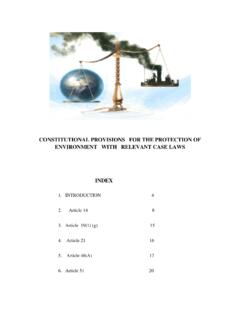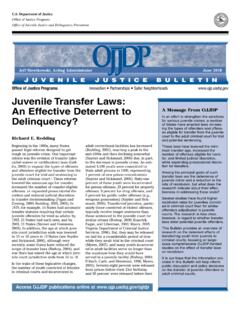Transcription of D. ROYALTIES - IRS tax forms
1 D. ROYALTIES 1. Introduction From the enactment of the tax on unrelated business income in 1950 (the "Supplement U Tax"), the modification for ROYALTIES has been one of the cornerstones of this complex statutory scheme. The purpose of this topic is to provide a basic understanding of what ROYALTIES are, explain how the Service and the courts have interpreted and applied the royalty provision, and describe what changes are being considered with respect to ROYALTIES , as Congress continues its comprehensive review of the entire area of unrelated business taxable income. Issues as varied as oil, gas and mineral interests, patents, and credit cards will be discussed in the context of the applicability of the royalty exclusion. 2. Background A. Code and Regulations Under IRC 511 a tax is imposed on the unrelated business taxable income of most exempt organizations. The term "unrelated business taxable income" is defined in IRC 512(a)(1) as the gross income derived by any organization from any unrelated trade or business regularly carried on by it, less directly connected deductions.
2 Both the unrelated trade or business and the directly connected deductions must be computed with the modifications contained in IRC 512(b). The royalty modification is contained in IRC 512(b)(2), which excludes from the computation of unrelated business taxable income "..all ROYALTIES (including overriding ROYALTIES ) whether measured by production or by gross or taxable income from the property, and all deductions directly connected with such income." This modification is essentially the same as that contained initially in section 301 of the Revenue Act of 1950. Other statutory provisions affecting the royalty modification can be found in IRC 512(b)(13), which discusses controlled organizations, and IRC 514, which discusses unrelated debt-financed income. Issues concerning controlled organizations under IRC 512(b)(13) and unrelated debt-financed income under IRC 514 are beyond the scope of this article, but both provisions have been the subject of previous CPE topics.
3 See the 1987 CPE Text, Topic D, beginning at p. 52 for a discussion of controlled organizations; see also the 1986 CPE Text, Topic N, beginning at p. 171 for a discussion of unrelated debt-financed income. In summary, the exclusion for royalty income is not available to an exempt organization, where such income is derived from a controlled organization, or from debt-financed property. Reg. (b)-1 contains a general provision affecting all the modifications contained in IRC 512(b), including ROYALTIES . In general, the regulation provides that whether a particular item of income falls within any of the IRC 512(b) modifications must be determined by all the facts and circumstances of each case. An example given by the regulations is where a payment termed "rent" by the parties is in fact a return of profits by a person operating the property for the benefit of the exempt organization or is a share of the profits retained by such organization as a partner or joint venturer.
4 Under these circumstances, such payment is not within the modification for rents. The same conclusion would be reached if such payments were characterized as " ROYALTIES ." The specific regulatory provision that discusses ROYALTIES is found in Reg. (b)-1(b) and reads as follows: " ROYALTIES , including overriding ROYALTIES , and all deductions directly connected with such income shall be excluded in computing unrelated business taxable income. However, for taxable years beginning after December 31, 1969, certain ROYALTIES from, and certain deductions in connection with , either debt-financed property (as defined in section 514(b) or controlled organizations (as defined in paragraph (1) of this section) shall be included in computing unrelated business taxable income. Mineral ROYALTIES shall be excluded whether measured by production or by gross or taxable income from the mineral property. However, where an organization owns a working interest in mineral property, and is not relieved of its share of the development costs by the terms of any agreement with an operator, income received from such an interest shall not be excluded.)
5 To the extent not treated as a loan under section 636, payments in discharge of mineral production payments shall be treated in the same manner as royalty payments for the purpose of computing unrelated business taxable income. To the extent treated as a loan under section 636, the amount of any payment in discharge of a production payment which is the equivalent of interest shall be treated as interest for purposes of section 512(b)(1) and paragraph (a) of this section." It should be noted that neither the Code nor the regulations provides an actual definition of the term " ROYALTIES ." Such definition has been left to the courts and, in some instances, to the dictionary. For purposes of IRC 512(b)(2), probably the best definition of " ROYALTIES " can be found in Rev. Rul. 81-178, discussed below. B. Revenue Rulings 1. Endorsements and Personal Appearances Rev. Rul. 81-178, 1981-2 135, describes two situations involving an IRC 501(c)(5) labor organization formed to improve the economic and working conditions of its members, who are professional athletes.
6 In Situation 1, the organization solicits and negotiates licensing agreements with various businesses. The licensing agreements authorize the businesses to use the organization's trademarks, trade names, service marks, copyrights, and members' names, photographs, likenesses, and facsimile signatures. Each of these things would be used by the businesses in connection with selling, promoting and advertising goods or services. The organization has the right to approve the quality or style of the licensed goods or services. Income from the agreements is sometimes based on a percentage of gross sales of the goods or services, while in other instances an annual flat fee is paid to the organization. In Situation 2, the agreements are concerned with endorsing products and services and require personal appearances by and interviews with the organization's members. The revenue ruling contains the following significant statement with respect to ROYALTIES : "To be a royalty, a payment must relate to the use of a valuable right.
7 Payments for the use of trademarks, trade names, service marks or copyrights, whether or not payment is based on the use made of such property, are ordinarily classified as ROYALTIES for federal tax purposes." This finding is supported by references to a number of court cases including Commissioner v. Affiliated Enterprises, Inc., 123 665 (10th Cir. 1941) cert. den. 325 812 (1942); Commissioner v. Wodehouse, 337 369 (1949); Rohmer v. Commissioner, 153 61 (2d Cir. 1946); and, Sabatini v. Commissioner, 98 753 (2d Cir. 1938). The revenue ruling also notes that payments for the use of a professional athlete's name, photograph, likeness or facsimile signature are ordinarily characterized as ROYALTIES . See Cepeda v. Swift & Co., 415 1205 (8th Cir. 1969) and Uhlaender v. Henricksen, 316 F. Supp. 1277 ( Minn. 1970). On the basis of these precedents, Rev. Rul. 81-178 holds that in Situation 1, since the payments from the licensing agreements are for the use of the organization's trademarks, trade names, service marks, copyrights, and its members' names, photographs, likenesses, and facsimile signatures, such amounts are ROYALTIES under IRC 512(b)(2).
8 This conclusion is not altered by the organization's right to approve the quality or style of the licensed products and services, since the mere retention of quality control rights does not cause payments to lose their characterization as ROYALTIES . The revenue ruling also holds that in Situation 2, since the agreements require the personal services of the organization's members, the payments received are compensation for personal services and not ROYALTIES under IRC 512(b)(2). 2. Patents Rev. Rul. 73-193, 1973-1 262, describes an IRC 501(c)(3) scientific research organization which evaluates, processes, promotes, develops, and manages the inventions of faculty and staff members of educational and scientific institutions. The organization requires that it be assigned title to the inventions, for which it obtains patents, introduces the patents for public use, and negotiates licenses. The organization collects royalty income from licenses, retains a portion of such amounts, and distributes 2the remainder to the institutions and inventors.
9 Citing Reg. (b)-1, set forth above, the revenue ruling states that the organization holds only bare legal title to the inventions for the purpose of performing patent development and management services on behalf of the beneficial owners of the inventions - the institutions and inventors. Under these circumstances, although the amounts are derived from ROYALTIES , they do not retain their character in the hands of the organization and, therefore, do not constitute ROYALTIES under IRC 512(b)(2). Three years later, Rev. Rul. 73-193 was distinguished by Rev. Rul. 76-297, 1976-2 178. This revenue ruling describes an IRC 501(c)(3) scientific organization that accepts inventions of individuals associated with a university for evaluation and possible patent consideration. When the organization files a patent application, the inventor assigns both legal and beneficial rights in the invention to the organization, which agrees to pay a specified percentage of ROYALTIES received from licensees.
10 The revenue ruling concludes that since the organization is both the beneficial and legal owner of the patents, amounts paid pursuant to licensing agreements are ROYALTIES which fall within IRC 512(b)(2). Rev. Rul. 76-297 distinguishes Rev. Rul. 73-193 on the basis that the organization described in Rev. Rul. 73-193 held only bare legal title to the patents, while the organization described in Rev. Rul. 76-297 is both the beneficial and legal owner of its patents. 3. Mineral Interests Rev. Rul. 69-179, 1969-1 158, describes an exempt organization that derives income from a working interest in an oil and gas property. In the situation described, although the organization is relieved of the development costs, it is liable for the operating costs associated with its interest. Under these circumstances the revenue ruling holds that the amounts derived from the mineral interest are not ROYALTIES under IRC 512(b)(2). The general rule under Reg.













